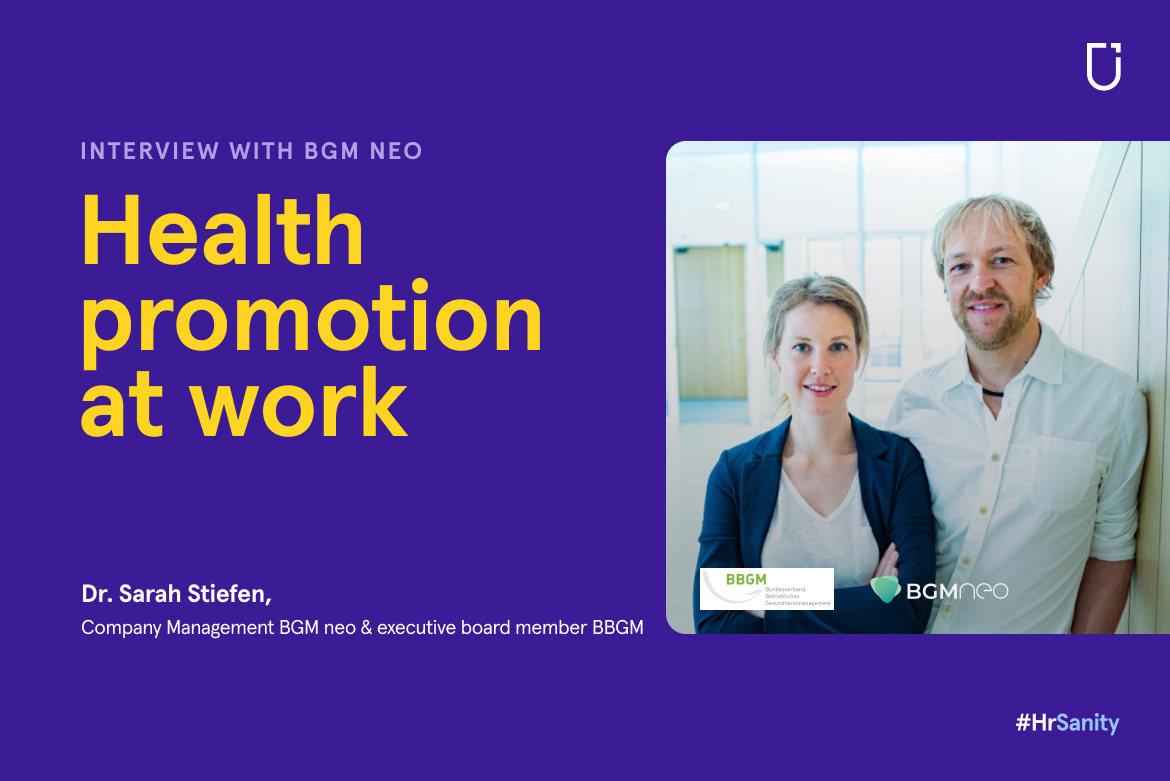Interview partners: Dr. Sarah Siefen, BGM neo management and board member of the German Association for Occupational Health Management and Daniela Maiorovici, Senior PR Manager at Urban Sports Club.
Healthy team leadership starts with healthy leaders. In times of crisis, stress and uncertainty, employees know they can turn to HR for support and guidance. But who can HR and other company leaders turn to? It’s HR’s role to do everything they can to support their employees during difficult times while maintaining their own professional and personal responsibilities. It’s easy to forget that HR are also affected by stressful situations, however they don’t have the same designated support system. The solution? Creating healthy routines and implementing self-care into everyday life.
Tell us a bit about BGM neo and its approach and objectives.
BGM neo stands for innovative and holistic occupational health management. The concept is based on a combination of mental and physical health, supplemented by social opportunities such as workshops on team building, management culture and corporate culture.
We focus on employee experiences that increase self-efficacy and promote health and well-being. Our goal is to develop a heightened awareness of workplace health and health management to help more companies thrive along with their employees in the long term.
How do you assess workplace health management within German companies? What are the key indicators that a company needs your support?
Awareness of occupational health management (OHM) is increasing however, companies aren’t well-informed of the difference between workplace health promotion (WHP) and workplace health management (WHM) and the associated processes and benefits. In this area there’s plenty of room for development.
The pandemic has made it more difficult to implement measures internally, especially for small and medium-sized companies. This is due to a shortage of resources and budgets, which means health and wellbeing gets pushed down the list of priorities. As a result the issue gets put on ice, even though workplace health management is even more important during challenging times.
Digital health offers have grown exponentially during the pandemic, which has been well-received within the corporate world. However not all company employees have the correct hardware to access these offers which limits the feasibility of implementation.
Do you have any examples of when BGM has successfully implemented its offer?
I cannot name any names, but I can share a practical example from the IT sector.
We worked with a company to develop a unique and holistic strategy during the pandemic. We implemented the concept in stages, with the aim of motivating and inspiring small groups of employees to learn tips and techniques to strengthen their immune systems. Our evaluation showed that the employees expanded their knowledge, their ability to boost their immune systems and improved their well-being at the same time.
How important is the role of HR managers when implementing these strategies?
HR managers are often the first point of contact and play a key role in connecting us with company management, the divisional managers and the employees. As a result, they’re often involved in strategy development and decision-making throughout the process.
HR managers are aware of the company’s internal needs, corporate goals and BGM’s objectives, and their knowledge is essential for the successful implementation of the BGM process. HR supports and promotes the implementation of our offer and gives employees transparency over our aims and visions. As a result, HR needs to have an open mind and enthusiasm for the topic of occupational health, as this spirit will spread throughout the company.
Often people don’t even realize they’re suffering from stress. What should people look out for? How can we recognize and address the symptoms?
Stress is part of everyday life, so one starting point is for individuals to reflect on their mood and outlook to understand how they deal with stress and if they’re managing it in a healthy way.
Symptoms of strong or even chronic stress include restlessness, insomnia, headaches, exhaustion, irritability, weakened immune system and digestive difficulties. When employees are displaying these symptoms, companies should take urgent action to prevent long-term health issues such as burn-out.
Managers serve as role models and should provide immediate support to employees suffering from stress. In addition to analyzing stress factors through psychological risk assessments, work situation analyses and personal discussions, managers should consider reducing the workload of the employee and implementing changes to create a better work-life balance.
Personal development is also a great way to strengthen self-efficacy. The focus here is on strengthening employees’ resources (e.g. through workshops or seminars) to help them develop effective coping strategies which will help them stay healthy in the long term.
Personal question – how do you maintain your own work-life balance?
Fixed routines help me personally. For example, I jog the same route every two days.
I also have different tools within my daily routine which help me de-stress. These include sports, walks with my dog, creative activities and conscious cooking. Continuous development is also important to me – I’m inspired by books and podcasts and take great pleasure in trying out and learning new things, such as unicycling and learning how to play handpan.
I also regularly pursue activities that bring me joy, even in difficult times, such as kickboxing, yoga and meditation.

